#Judicial History
Note
Did the confederacy have a supreme court and if so who was the chief justice
The structure of the Confederate government, as shaped by the Constitution of Confederate States of America, was very similar to that outlined by the United States Constitution with the three branches of government: executive, legislative, and judicial. The Confederacy was attempting to stand up a new federal government of their own while also staying true to their supposed adherence to the importance of the rights of each of the individual states that had seceded from the Union before forming the Confederacy, so that caused many complications with getting the institutions of government off the ground, especially since they were in the midst of a brutal war of rebellion.
Given those complications, it's actually kind of surprising how successful they were in getting the Executive and Legislative branches started, first provisionally and then officially after their first federal elections. However, formally establishing the Supreme Court defined by the Confederate Constitution (in Article III, just as in the United States Constitution) was something that never happened, so there was no judiciary above the level of District Courts and no Chief Justice nominated by Confederate President Jefferson Davis. As in the United States, the President of the Confederacy was responsible for appointing federal judges and while the Supreme Court was never established, President Davis did appoint District Court judges -- many of whom had previously been the U.S. District Court judge for that particular jurisdiction prior to secession.
#History#Confederate States of America#Confederacy#Judiciary#Supreme Court#Confederate Constitution#Constitution#Judicial Branch#Confederate Supreme Court#Confederate Judiciary#Constitution of the Confederate States of America#Politics#Law#Judicial History#Jefferson Davis#President Davis#Confederate President#Confederate History#Civil War#Secession#Confederate Government
8 notes
·
View notes
Note
Why was queens pardoning prisoners seen as good? Like murders and sexual assaulter ect? Wouldn’t the public be against that?
This is an area where I think Foucault was actually right:
"...The public execution is to be understood not only as a judicial, but also as a political ritual. It belongs, even in minor cases, to the ceremonies by which power is manifested....
The public execution, then, has a juridico-political function. It is a ceremonial by which a momentarily injured sovereignty is reconstituted. It restores that sovereignty by manifesting it at its most spectacular. The public execution, however hasty and everyday, belongs to a whole series of great rituals in which power is eclipsed and restored (coronation, entry of the king into a conquered city, the submission of rebellious subjects); over and above the crime that has placed the sovereign in contempt, it deploys before all eyes an invincible force. Its aim is not so much to re-establish a balance as to bring into play, as its extreme point, the dissymmetry between the subject who has dared to violate the law and the all-powerful sovereign who displays his strength. Although redress of the private injury occasioned by the offence must be proportionate, although the sentence must be equitable, the punishment is carried out in such a way as to give a spectacle not of measure, but of imbalance and excess; in this liturgy of punishment, there must be an emphatic affirmation of power and of its intrinsic superiority. And this superiority is not simply that of right, but that of the physical strength of the sovereign beating down upon the body of his adversary and mastering it by breaking the law, the offender has touched the very person of the prince; and it is the prince - or at least those to whom he has delegated his force - who seizes upon the body of the condemned man and displays it marked, beaten, broken. The ceremony of punishment, then, is an exercise of 'terror'...
The sovereign power that enjoined him to kill, and which through him did kill, was not present in him; it was not identified with his own ruthlessness. And it never appeared with more spectacular effect than when it interrupted the executioner's gesture with a letter of pardon...The sovereign was present at the execution not only as the power exacting the vengeance of the law, but as the power that could suspend both law and vengeance. He alone must remain master, he alone could wash away the offences committed on his person; although it is true that he delegated to the courts the task of exercising his power to dispense justice, he had not transfered it; he retained it in its entirety and he could suspend the sentence or increase it at will." (emphasis mine)
Michel Foucault, Discipline and Punish, ch. 2
Unlike a modern conception of criminal justice, which is premised as an objective, rational, truth-seeking process in which precise identification of the right suspect and their level of guilt and the appropriate nature of their punishment, criminal justice systems in premodern Europe (although not necessarily limited to the same) were meant to emphasize the terrifying arbitrariness of royal power. With rituals put in place in order to ensure guilt through public (often coerced) confessions, the point wasn't whether the sheriff and the judge had "got the right man" or whether "the punishment fits the crime," but that the king could either enact public displays of bodily obliteration or public displays of mercy at their sole discretion.
In a sense, the pardoning of the guilty was a necessary justification for the deliberately disproportionate brutality of a pre-carceral system of punishment. This promoted the logic of submission to the guilty and innocent alike: if the king could sentence you to the ultimate physical dehumanization whether or not you were guilty, the only hope was either the mountain and forest refuge of the outlaw or the hope of a pardon as a quasi-divine act of unearned grace.
58 notes
·
View notes
Text
Is antitrust anti-labor?
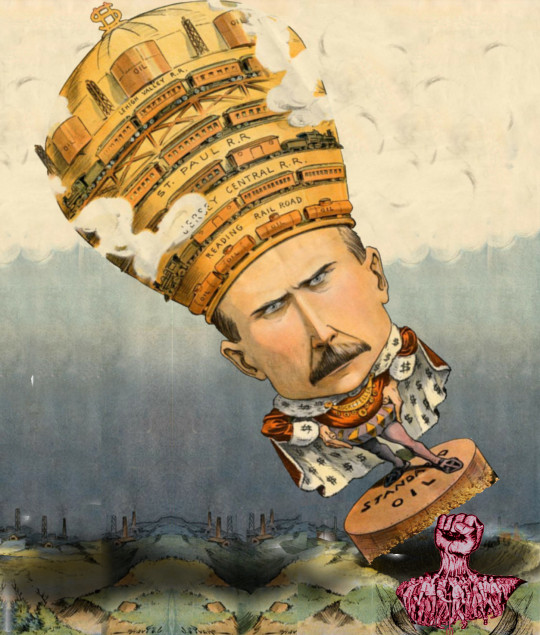
If you find the word “antitrust” has a dusty, old-fashioned feel, that’s only to be expected — after all, the word has its origins in the late 19th century, when the first billionaire was created: John D Rockefeller, who formed a “trust” with his oil industry competitors, through which they all agreed to stop competing with one another so they could concentrate on extracting more from their workers and their customers.
If you’d like an essay-formatted version of this post to read or share, here’s a link to it on pluralistic.net, my surveillance-free, ad-free, tracker-free blog:
https://pluralistic.net/2023/04/14/aiming-at-dollars/#not-men
Trusts were an incredibly successful business structure. A bunch of competing companies would be sold to a new holding company (“the trust”), and the owners of those old standalone companies would get stock in this new trust. The trust would operate as a single entity, hiking prices and suppressing wages. If anyone tried fight the trust with a new, independent company, the trust could freeze them out, by selling goods below cost, or by doing exclusive deals with key suppliers and customers, or both. Once a trust sewed up an industry, no one could compete. The trust barons were rulers for life.
The first successful trust was Rockefeller’s Standard Oil, which amassed a 90% share of all US oil. Other “capitalists” got in on the game, forming the Cotton Seed Oil Trust (75% market share), the Sugar Trust (85%). Then came the Whiskey Trust and the Beef Trust. America was becoming a planned economy, run by a handful of unelected “industrialists” with lifetime appointments and the power to choose their successors.
A century after overthrowing the King, America had new kings: “kings over the production, transportation and sale of the necessities of life”. That’s how Senator John Sherman described the situation in 1890, when he was campaigning for the passage of the Sherman Act, the first “anti-trust” act. The Sherman Act wasn’t the first time American lawmakers tried to protect competition, but it was the first law passed after the failure of competition law led to the hijacking of the nation by people Sherman called the “autocrats of trade.”
https://marker.medium.com/we-should-not-endure-a-king-dfef34628153
The Sherman Act — and its successors, like the Clayton Act, are landmark laws in that they explicitly seek to protect workers and customers from corporate power. Antitrust is about making sure that no corporation gets so powerful that it’s too big to fail, nor too big to jail — that a company can’t get so big that it subverts the political process, capturing its own regulators:
https://doctorow.medium.com/small-government-fd5870a9462e
If American workers are derided as “temporarily embarrassed millionaires” who won’t join the fight against the rich because they assume they’ll soon join their ranks, then the American rich are “temporarily embarrassed aristocrats” who would welcome hereditary rule, provided they got to found one of the noble families. The goal of the American elite has always been to create a vast and durable dynasty, wealth so vast and well-insulated that even the most Habsburg-jawed failson can’t piss it away.
The American elite has always hated antitrust. In the 1980s, Ronald Reagan, abetted by Robert Bork and his co-conspirators at the Chicago School of Economics gutted antitrust through something called the “consumer welfare standard,” which ended anti-monopoly enforcement except in instances where price hikes could be directly and unarguably attributed to market power, which is, basically, never.
It’s been 40 years since Reagan took antitrust out behind the Lincoln Monument and shot it in the guts, and America has turned into the kind of aristocratic kleptocracy that Sherman railed against, where “great families” control the nation’s wealth and politics and even its Supreme Court judges:
https://pluralistic.net/2023/04/06/clarence-thomas/#harlan-crow
Anything that can’t go on forever will eventually stop. Monopoly threatens the living standards, health, freedom and prosperity of nearly every person in America. The undeniable enshittification of the country by its guillotine-ready finance ghouls, tech bros and pharma profiteers has led to a resurgence in antitrust, and a complete renewal of the @FTC and @JusticeATR:
https://www.eff.org/deeplinks/2021/08/party-its-1979-og-antitrust-back-baby
Key to the new and vibrant FTC is Commissioner Alvaro Bedoya, who, along with Commissioner Rebecca SlaughterFTC and Chairwoman Lina Khan, is part of the Democratic majority on the Commission. Bedoya has a background in tech and privacy and civil rights, and is a longtime advocate against predatory finance. He’s also a law professor and a sprightly scholarly writer.
Earlier this week, Bedoya gave a prepared speech for the Utah Project on Antitrust and Consumer Protection conference, entitled “Aiming at Dollars, Not Men.” It’s a banger:
https://www.ftc.gov/system/files/ftc_gov/pdf/bedoya-aiming-dollars-not-men.pdf
Criticisms of the new antitrust don’t just come from America’s oligarchs — the labor movement is skeptical of antitrust as well, and with good cause. Antitrust law prohibits collusion among businesses to raise prices, and at many junctures since the passage of the Sherman Act, judges have willfully perverted antitrust to punish labor organizers, treating workers demanding better working conditions as if they were Rockefeller and his cronies conspiring to raise prices.
This is the subject of Bedoya’s speech, whose transcript is painstakingly footnoted, and whose text makes it crystal clear that this is not what antitrust is for, and we should not tolerate its perversion in service to crushing worker power. The title comes from a 1914 remark by Democratic Congressman Thomas Konop, who said, of antitrust: “We are aiming at the gigantic trusts and combinations of capital and not at
associations of men for the betterment of their condition. We are aiming at the dollars and not at men.”
Konop was arguing for the passage of the Clayton Act, a successor to the Sherman Act, which was passed in part because judges refused to enforce the Sherman Act according to its plain language and its legislative intent, and kept using it against workers. In 1892, two years after the Sherman Act’s passage, it was used to crush the New Orleans General Strike, an interracial uprising against labor exploitation from longshoremen to printers to carpenters to hearse drivers.
Bosses went to a federal judge asking for an injunction against the strike. Though the judge admitted that the Sherman Act was designed to fight “the evils of massed capital,” he still issued the injunction.
The Sherman Act was used to clobber the Pullman Porters union, which organized Black workers who served on the Pullman cars on America’s railroads. The workers struck in 1894, after a 25% wage-cut, and they complained that they could no longer afford to eat and feed their families, so George Pullman fired them all. The workers struck, led by Eugene Debs. Pullman argued that the strike violated the Sherman Act. The Supreme Court voted 9:0 for Pullman, ordered the strike called off, and put Debs in prison.
In 1902, mercury-sickened hatters in Danbury, CT demanded better working conditions — after just a few years on the job, hatters would be disabled for life with mercury poisoning, with such bad tremors they couldn’t even feed themselves. 250 hatters at the DE Loewe company tried to unionize. Loewe sued them under the Sherman Act, and went to the Supreme Court, who awarded Loewe $6.8m in today’s money, which allowed Loewe to seize his former workers’ homes.
This is what sent Congress back to the drawing board to pass the Clayton Act. Though the Sherman Act was clear that it was about trustbusting, the courts kept interpreting it as a charter for union-busting. The Clayton Act explicitly permits workers to form unions, call for boycotts, and to organize sympathy strikes.
They made all this abundantly clear: writing in language so plain that judges had to understand the legislative intent. And yet…judges still managed to misread the Clayton Act, using it to block 2,100 strikes in the 1920s. It appears that passing the Clayton Act did not save a single strike that would have been killed by the bad (and bad faith) Sherman Act precedents that led to the Clayton Act in the first place.
The extent to which greedy bosses used the Clayton Act to attack their workers is genuinely ghastly. Bedoya describes one coal strike, against the Red Jacket Coal Company of Mingo, WV. The mine’s profits had grown by 600%, but workers’ wages weren’t keeping up with inflation. The miners sought a raise of $0.10 on the $0.66 they got paid for ever carload of coal they mined. The company didn’t even pay the workers with real money — just “company scrip”: coupons that could only be spent at the company store. Red Jacket gave its workers a $0.09/car raise — and raised prices at the company store by $0.25/item.
The workers struck, Red Jacket sued. The Fourth Circuit refused to apply the Clayton Act, following a precedent from a case called Duplex Printing that held that the Clayton Act only applied to people who stood “in the proximate relation of employer and employee.”
Congress was pissed. They passed the Norris-LaGuardia Act of 1932, with LaGuardia spitting about judges who “willfully disobeyed the law…emasculating it, taking out the meaning intended by Congress, making the law absolutely destructive of Congress’s intent.” Norris-LaGuardia creates an antitrust exemption for labor that applies “regardless of whether the disputants stand in the proximate relation of employer and employee.” So, basically: “CONGRESS TO JUDGES, GET BENT.”
And yet, judges still found ways to use antitrust as a cudgel to beat up workers. In Columbia River Packers, the court held that fishermen weren’t protected by the exemption for workers, because they were selling “commodities” (e.g. fish) not their labor. Presumably, the fish just leapt into the boats without anyone doing any work.
The willingness of enforcers to misread antitrust continued down through the ages. In 1999, the FTC destroyed the hopes of the some of the country’s most abused workers: “independent” port truckers, who worked 80 hours/week and still couldn’t pay the bills. Truckers were only paid to move trailers around the ports, but they were required to do hours and hours of unpaid work — loading containers, hauling equipment for repair, all for free. The truckers tried to organize a union — and the FTC subpoenaed the organizers for an investigation of price-fixing.
But the problem wasn’t with the laws. It was with judges who set precedents that — as LaGuardia said, “willfully disobeyed the law…emasculating it, taking out the meaning intended by Congress, making the law absolutely destructive of Congress’s intent.”
Congress passed laws to strengthen workers and judges — temporarily embarrassed aristocrats — simply acted as if the law was intended to smash workers. But by 2016, judges had it figured out. That’s when jockeys at the Camarero racetrack in Canóvana, Puerto Rico went on strike, demanding pay parity with their mainland peers — Puerto Rican jockeys got $20 to risk their lives riding, a fifth of what riders on the mainland received.
Predictably, the horse owners and racetrack sued. The jockeys lost in the lower court, and the court ordered the jockeys to pay the owners and the track a million dollars. They even sued the jockeys’ spouses, so that they could go after their paychecks to get that million bucks.
The case went to the First Circuit appeals court and Judge Sandra Lynch said: you know what, it doesn’t matter if the jockeys are employers or contractors. It doesn’t matter if they sell a commodity or their labor. The jockeys have the right to strike, period. That’s what the Clayton Act says. She overturned the lower court and threw out the fines.
As Bedoya says, antitrust is “law written to rein in the oil trust, the sugar trust, the beef trust…the gigantic trusts and combinations of capital…dollars and not at men.” Congress made that plain, “not once, not twice, but three times, each time in a louder and clearer
voice.”
Bedoya, part of the FTC’s Democratic majority, finishes: “Congress has made it clear that worker organizing and collective bargaining are not violations of the antitrust laws. When I vote, when I consider investigations and policy matters, that history will guide me.”

There's only three days left in the Kickstarter campaign for the audiobook of my next novel, a post-cyberpunk anti-finance finance thriller about Silicon Valley scams called Red Team Blues. Amazon's Audible refuses to carry my audiobooks because they're DRM free, but crowdfunding makes them possible.
#pluralistic#jockeys#antitrust#labor#history#judicial overreach#Alvaro Bedoya#consumer welfare standard#trustbusting#sherman act#new orleans general strike of 1892#pullman union#pullman porters#eugene debs#mad hatters#danbury hatters#clayton act#red jacket coal company#Fiorello LaGuardia#Norris-LaGuardia Act#duplex printing#Columbia River Packers#puerto rico#Camarero racetrack
219 notes
·
View notes
Text

On November 8th 1576 Elizabeth Bessie Dunlop was found guilty of Witchcraft and sentenced to be burnt at the stake.
Today, she would have been seen as a wise woman, a psychic or a medium. But when Bessie Dunlop went on trial in Edinburgh in 1576, she was quickly branded “The Witch of Dalry”, tortured, then burned at the stake.
For years, she had been helping locals with potions, predictions and cures for cattle. But she was an early victim of the Scottish witch purges, when the saying: “Thou shalt not suffer a witch to live” was taken literally.
Records of Bessie’s trial survived through the centuries and, perhaps because of that, she remains one of Scotland’s most famous “witches”. Plays and books have been written about her over the years.
Most recent accounts portray Bessie as a woman who helped locals and their livestock with herbal cures. She also claimed to possess “second sight” – and talked to spirits and “fairies”.
Under torture, most witches would admit to almost anything – from consorting with the Devil, putting curses on locals or even killing children. Not Bessie.
Instead, she claimed merely to have met with a spirit guide, who introduced her to the fairy folk, who resided in Cleeves Cove – the secluded caves just a mile and a half from Dalry.
In her confession, she claimed that while taking her cow to a field, she came across an elderly man with a grey beard.
He claimed to be the spirit of Thomas Reid, a former Baron Officer to John Blair of Dalry, who had been killed at the battle of Pinkie in 1547.
At the time Bessie was stressed with worry, her child, husband and cow were ill, and it seemed that they would not recover. The old man comforted her and predicted that her cow and child would die, but her husband would make a full recovery. He then disappeared down a hole in a dyke that was to be much too small to let any mortal man pass by it.
On their next meeting, the strange apparition offered her material goods in the form of horses and cows if she would denounce Christianity. She refused and said that she would rather be whipped. The angry spirit disappeared.
On his return, he introduced her to the ‘fairies’. Swearing secrecy, he introduced her to four men and eight women of Elfame, another name for the fairy realm. They were dressed as humans but very smartly, the men like gentlemen, and the women had ‘all plaids about them’. They were very friendly towards Bessie but when she refused to go with them ,they left with a “hideous ugly blast of wind” leaving Bessie lying sick on the ground.
She claimed her spirit mentor taught her how to cure cattle and children. People came to her for advice on a regular basis and her reputation was beginning to spread. She was allegedly even able to tell people the location of missing items.
And it wasn’t just the poor folk of the town who consulted her.
Lady Johnstone sent a servant to consult her regarding the sickness of her daughter. Bessie in turn consulted Thomas. “Her sickness,” he is recorded as having told her, “is due to cauld blood that went about her heart, that caused her to pine away. Therefore, let her take equal parts of cloves, ginger, annis-seed, and liquorice, and mix them together in ale; seethe them together; strain the mixture; put it in a vessel, then take a little quantity of it in a mutchkin can, with some white sugar cast among it; take and drink thereof each day in the morning; walk a while after, before meat, and she would soon be better.” Bessie was also consulted by Lady Blackhall and received as payment a peck of meal and some cheese. Lady Thirdpart, in the barony of Renfrew, sent to her to discover who had stolen some coins out of her purse – Bessie named the culprit.
She was also consulted by the daughter of William Blair of Strand, who was to be married to the Laird Crawford of Baidland. Thomas, speaking through Bessie, suggested that if she were to marry him she would come to an untimely demise by her own hand. The wedding plans were dropped and the laird finally married the woman’s sister.
Thomas also allegedly predicted that Bessie would face trial for her dealings with the spirit world, but her neighbours would save her from evil. Sadly for Bessie, that prediction failed to come true.
The crime of which she was accused was “sorcery, witchcraft, and incantation, with invocation of spirits of the devil, continuing in familiarity with them at all such times as she thought expedient, dealing with charms, and abusing the people with devilish craft of sorcery aforesaid”.
Bessie is believed to have been burned to death on Edinburgh’s Castle Hill.
An alternative legend claims she was brought back to Ayrshire and burned at Corsehillmuir, Kilwinning. The court records fail to describe her final fate.
An ongoing campaign goes on in Scotland to have all those who were killed after a witchcraft conviction, tro be pardoned.
49 notes
·
View notes
Text
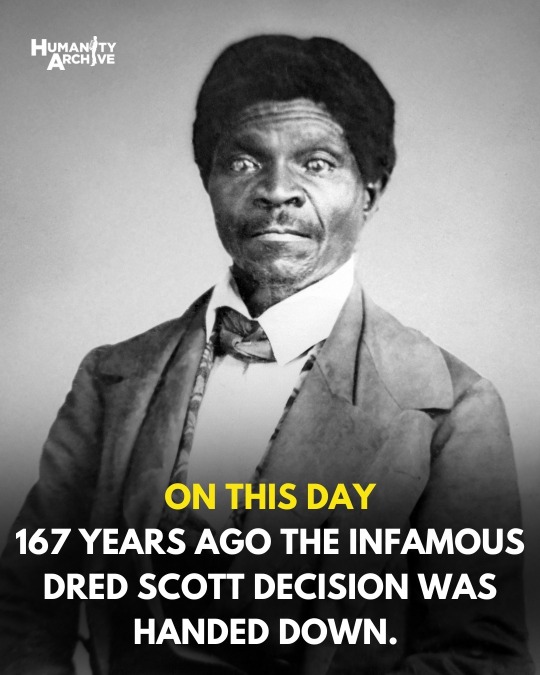
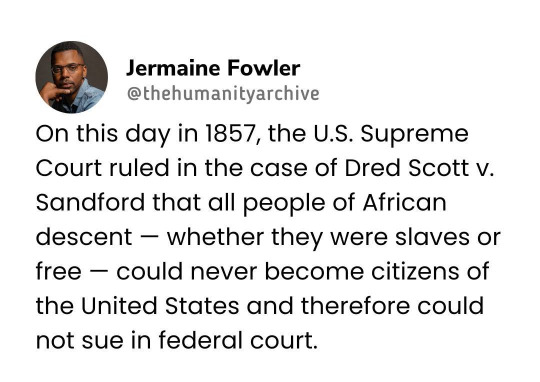

#racism#white racial hatred#white supremacy#white evil#dred scott v. sandford#u.s. supreme court#citizenship rights#racial discrimination#legal precedent#civil rights history#slavery#judicial activism#constitutional interpretation
16 notes
·
View notes
Text
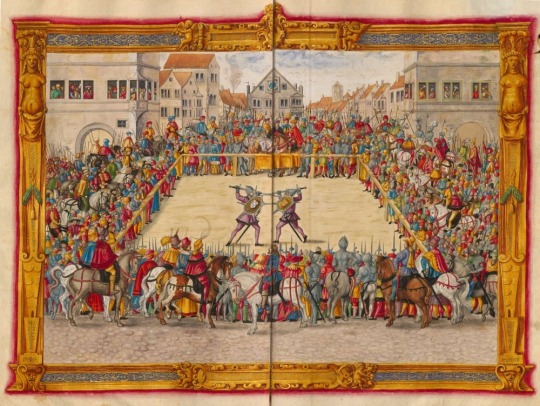
Judicial duel between Marshal Wilhelm von Dornsberg and Theodor Haschenacker in the Augsburg wine market (1409). Dornsberg's sword broke early in the duel, but he succeeded to kill Haschenacker with this gentleman’s own sword. Their shields were kept in St. Leonard’s Church outside of Augsburg until it was destroyed in 1542.
#judicial#duel#trial by combat#trial#combat#duelling#germanic law#fighting#art#history#europe#european#medieval#middle ages#knights#gentlemen#wine market#augsburg#german#germany#marshal wilhelm von dornsberg#theodor haschenacker#sword#gentleman#knight#wepaons#armour#swords#shields
40 notes
·
View notes
Text
#leonard leo#ginni thomas#harlan crow#u.s. supreme court#clarence thomas#dark money#citizens united#republicans#judicial ethics#unequal justice#pushing on the scales of justice#u.s. history#should be taught in u.s. history classes
4 notes
·
View notes
Photo
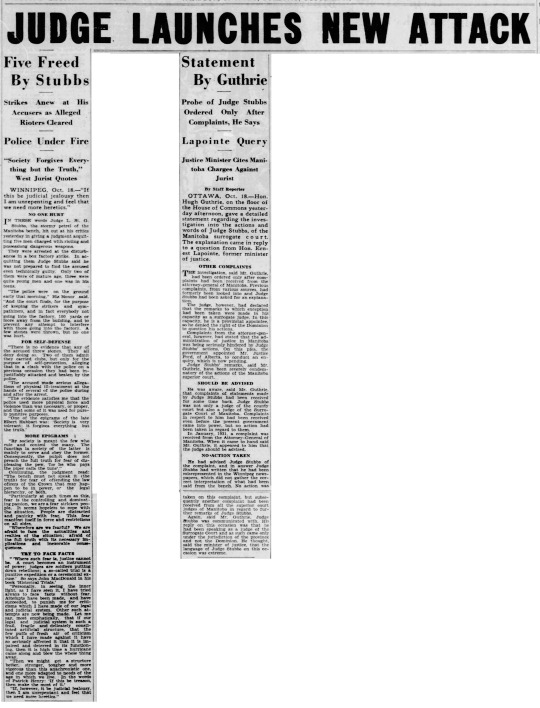
“Judge Launches New Attack,” Border Cities Star. October 18, 1932. Page 19.
---
Five Freed By Stubbs
----
Strikes Anew at His Accusers as Alleged Rioters Cleared
===
Police Under Fire
---
“Society Forgives Everything But the Truth,” West Jurist Quotes
----
WINNIPEG, Oct. 18. ‘If this be judicial jealousy then I am unrepenting and feel that we need more heretics.’
NO ONE HURT
IN THESE words Judge L. St. G. Stubbs, the stormy petrel of the Manitoba bench, hit out at his critics yesterday in giving a judgment acquitting five men charged with, rioting and possessing dangerous weapons.
They were arrested at the disturbances in a box factory strike. In acquitting them Judge Stubbs said he was not prepared to find the accused even technically guilty. Only two of them were of mature age, three were quite young men and one was In his teens.
"The police were on the ground early that morning," His Honor said. "And the court finds, for the purpose of keeping the strikers and sympathizers. and In fact everybody not going Into the factory. 100 yards or more away from the building, and to prevent any attempt to Interfere with those going Into the factory. A few stones were thrown, but no one was hurt.
FOR SELF-DEFENSE
"There is no evidence that any of the accused threw stones. They all deny doing so. Two of them admit they carried clubs, but only for the purpose of self-protection, alleging that In a clash with the police on a previous occasion they had been ln-justifiably attacked and beaten by the police.
"The accused made serious allegations of physical ill-treatment at the hands of several of the police during and after the arrest.
“The evidence satisfies me that the police used more physical force and violence than was necessary, or proper, and that some of it was used for purely punitive purposes. One of the epigrams of the late Elbert Hubbart was: ‘Society is very tolerant; it forgives everything but the truth.
MORE EPIGRAMS
“By society is meant the few who rule and control the many. The function in society of the latter is mainly to serve and obey the former. Consequently, the pulpit does not preach the full truth for fear of displeasing the pew, 'for he who pays the piper calls the tune’.”
Continuing, the judgment read: "The bench must not speak it (the truth) for fear of offending the law officers of the Crown that may happen to be in power, or the legal hierarchy, or both.
"Particularly at such times as this, fear is the controlling and dominating passion, we are a fear stricken people. It seems hopeless to cope with the situation. People are distracted and panicky with fear. This fear manifest Itself in force and restrictions on all sides.
"Wherefore are we fearful? We are afraid to face the actualities and realities of the situation; afraid of the full truth with Its necessary Implications and inexorable consequences.”
TRY TO FACE FACTS
'Where such fear is, justice cannot be. A court becomes an instrument of power; judges are soldiers putting down rebellions; a so-called trial is a punitive expedition or a ceremonial excuse. So says John MacDonald in his book "Historical Trials”.”
"Personally, in seeing the inner light, as I have seen it, I have tried always to face facts without fear. Attempts have been made, and have succeeded, to punish me for criticisms which I have made of our legal and judicial system. Other such attempts are now being made. Let me say. most emphatically, that if our legal and judicial system is such a frail, fragile and delicately constituted artificial structure, that the few puffs of fresh air of criticism which I have made against It have so seriously affected it that it is impaired and deterred in its functioning. then it is high time a hurricane came along and blew the whole thing away.
“Then we might get a structure better, stronger, tougher and more vigorous than this anachronistic one, and one more adapted to needs of the age In which we live. In the words of Patrick Henry: 'If this be treason, then make the most of it.’
"If, however. it be judicial jealousy, then I am unrepentant and feel that we need more heretics.’
Statement By Guthrie
----
Probe of Judge Stubbs Ordered Only After Complaint, He Says
---
Lapointe Query
----
Justice Minister Cites Manitoba Charges Against Jurist
---
By Staff Reporter
OTTAWA, Oct. 18. Hon. Hugh Guthrie, on the floor of the House of Commons yesterday afternoon, gave a detailed statement regarding the investigation into the actions and words of Judge Stubbs, of the Manitoba surrogate court. The explanation came in reply to a question from Hon. Ernest Lapointe, former minister of justice.
OTHER COMPLAINTS
THE investigation, said Mr. Guthrie, had been ordered only after complaints had been received from the attorney-general of Manitoba. Previous complaints, from various sources, had formerly been looked Into and Judge Stubbs had been asked for an explanation.
The judge, however, had declared that the remarks to which exception had been taken were made in his capacity as a surrogate judge. In this capacity, he is a provincial appointee, so he denied the right of the Dominion to question his actions.
Complaints from the attorney-general. however, had stated that the administration of justice in Manitoba was being seriously hindered by Judge Stubbs’ actions. On this plea, the government appointed Mr. Justice Ford, of Alberta, to conduct an enquiry. which is now pending.
Judge Stubbs’ remarks, said Mr. Guthrie, have been severely condemnatory of the actions of the Manitoba superior court.
SHOULD BE ADVISED
He was aware, said Mr. Guthrie, that complaints of statements mads by Judge Stubbs had been received for some time back. Judge Stubbs was not only a judge of the county court but also a judge of the Surrogate Court of Manitoba. Complaints in respect to him had been received even before the present government came into power, but no action had been taken in regard to them.
In January. 1931. a complaint was received from the Attorney-General of Manitoba. When it came to hand said Mr. Guthrie, it appeared to him that the Judge should be advised.
NO ACTION TAKEN
He had advised Judge Stubbs of the the complaint, and in answer Judge Stubbs had written that he had been misrepresented in the Winnipeg newspapers. which did not gather the correct interpretation of what had been said from the bench. No action was taken on this complaint, but subsequently another complaint had been received from all the superior court judges of Manitoba in regard to further remarks of Judge Stubbs.
Again, said Mr. Guthrie. Judge Stubbs was communicated with. His reply on this occasion was that he had been speaking as a judge of the Surrogate Court and as such came only under the jurisdiction of the province and not the Dominion. He thought, said the minister of justice, tnat the language of Judge Stubbs on this occasion was extreme.
#winnipeg#strike#strike violence#penal reform#riot#unlawful assembly#police violence#strikebreakers#box factory#factory workers#judge stubbs#minister of justice#hugh guthrie#judicial apppointments#public inquiry#crime and punishment in canada#history of crime and punishment in canada#great depression in canada
1 note
·
View note
Link
Anyone who may have seen “The Last Duel,” a film from last year, and wants to learn some of the historical background behind what was portrayed in the movie should read this article. It is less about the film itself as it is about the historic system of using duels as a judicial practice, including how such a practice originated and ultimately was abolished. Know that the article includes spoilers about the movie if you are planning to watch it. "The Last Duel” did poorly at the box office, but I saw it after it left theaters and enjoyed it. Starring in the movie are Matt Damon and Adam Driver as the male leads and Jodie Comer as the female lead.
#2021#adam driver#article#cinema#france#french history#historical background#historical practice#historical system#history#interesting#jodie comer#judicial practice#judicial system#matt damon#medieval#middle ages#movie#society#the last duel
5 notes
·
View notes
Text
eventually i rly want to be raising bees, chickens, and angora rabbits
.....maybe black soldier flies too. for the chickens. and any fish i may be keeping at the time. and to work as hardcore composters
#if anyone is curious and missed it i went down a rabbit hole a while back#studying black soldier flies#and long story short theyre very good and arent disease vectors#ive also read that rabbit manure is like Amazing for gardening#and obv chicken manure has a long history of use#just gotta be more judicious with it afaik#oh so much studying ahead of me :')
1 note
·
View note
Text

I'll co-sign this and add it to the list of recommended Supreme Court books. I've read Supreme Conflict: The Inside Story of the Struggle for Control of the United States Supreme Court by Jan Crawford Greenburg (BOOK | KINDLE) and it's excellent and frighteningly prescient about what would happen ten years later under the successful Trump/McConnell push to finally reshape the Court and the federal judiciary, possibly for decades to come. And look at what that conservative-dominated Supreme Court has done in just the past three years.
#History#Books#Book Recommendations#Book Suggestions#Supreme Court#Judicial Branch#Judiciary#Federal Judiciary#Supreme Court Books#Supreme Conflict#Jan Crawford Greenburg#Hopefully we're talking about the same book!
41 notes
·
View notes
Note
Tyrion in his trial is not allowed to cross examine Cersei’s witnesses was that typical in medieval trials?
That was not unusual, no.
Indeed, William Garrow, a criminal defense barrister in the late 18th century was a major reformer in the adverserial legal system by innovating the practice of cross-examination as opposed to merely producing defense witnesses.
The BBC actually did a very good historical courtroom drama series based on his life's work:
youtube
#history#historical analysis#judicial system#judicial reform#medieval justice system#early modern justice system
20 notes
·
View notes
Link
2 notes
·
View notes
Text
George Stinney: A Boy Killed For Being Black
George Stinney: A Boy Killed For Being Black
#blacklivesmatters
#GeorgeStinney
This is the sad and hurtful story of George Stinney, One of the many instances of uncensored hate and disregard for black lives.
Michael Ogbedeagu writes from Facebook.
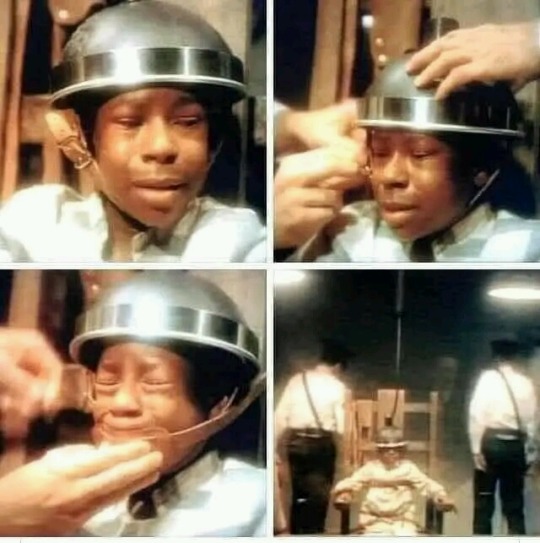
View On WordPress
#Black live matters#Black&039;s history#Blacks killed in the US#electric chair#extra judicial killings#Injustice#June 1944 in history#racism#The execution of George Stinney#The Holy bible#The youngest person to be executed in the 20th century#why was George stinney executed
1 note
·
View note
Text
in regards to the international court of justice ruling in favor of south africa's case, PLEASE do not fall into imperialistic pessimism. this is an unprecedented moment in history. even if the icj doesn't have absolute power to dismantle colonial forces (which no institution in the world has), even if there's still a long way to go between this ruling and a ceasefire, even if there's still so much to be done, this is the first time the occupational forces in palestine have been faced with this amount of international opposition, and it is strong international opposition that causes colonial forces to fall. do not fall into the "this is a theatre", "this is just symbolic", "this means nothing" discourse. bringing about freedom to palestine, and all colonized nations and peoples, includes judicial bureaucracy just as much as boycotting, violent opposition, blockades, sanctions etc. there has to be an official international position on the matter, and this is it. the icj ruling won't stop the occupation forces, but without this ruling things would be that much harder for the palestinian cause on the world stage. let's keep going from here.
#from the river to the sea palestine will be free#palestine#icj#icj hearing#international court of justice#free gaza#free palestine#colonialism#racism
17K notes
·
View notes
Text
By Jake Johnson
Common Dreams
Aug. 4, 2023
"Given the historic nature of the charges brought forth in these cases, it is hard to imagine a more powerful circumstance for televised proceedings."
Dozens of House Democrats on Thursday urged the policy-setting body of the federal judiciary to authorize live broadcasts of former President Donald Trump's upcoming court proceedings as he faces charges stemming from his effort to overturn the 2020 election.
Cameras are usually barred from federal courtrooms, but 38 House Democrats argued in a letter to the Judicial Conference that "given the historic nature of the charges brought forth in these cases, it is hard to imagine a more powerful circumstance for televised proceedings."
"It is imperative the conference ensures timely access to accurate and reliable information surrounding these cases and all of their proceedings, given the extraordinary national importance to our democratic institutions and the need for transparency," reads the letter, which was led by Reps. Adam Schiff (D-Calif.), Gerry Connolly (D-Va.), Hank Johnson (D-Ga.), and Bennie Thompson (D-Miss.).
"If the public is to fully accept the outcome, it will be vitally important for it to witness, as directly as possible, how the trials are conducted, the strength of the evidence adduced, and the credibility of witnesses," the letter continues. "We urge the conference to take additional steps, including live broadcasting, to ensure the facts of this case are brought forward, unfiltered, to the public."
The lawmakers released their letter shortly after Trump appeared in federal court in Washington, D.C. and pleaded not guilty to four felony counts laid out in a 45-page indictment filed earlier this week by Special Counsel Jack Smith, who was appointed in November to lead investigations into Trump's election subversion efforts and the January 6 attack.
The charges include conspiracy to defraud the United States and " conspiracy against the right to vote and to have one's vote counted."
The first pretrial hearing is set to take place on August 28.
The severity of the charges against Trump—who is seeking the presidency again in 2024—and the trial's massive implications have led legal experts to make the case for allowing video cameras into the courtroom.
Andrew Weissmann, a former top prosecutor at the Justice Department, toldVanity Fair on Thursday that the decision rests with the chief justice of the U.S. Supreme Court, John Roberts, who is the chair of the Judicial Conference.
"It's going to be incumbent on the chief justice of the United States to make this trial public," said Weissmann. "He has the power to do that."
Our work is licensed under Creative Commons (CC BY-NC-ND 3.0). Feel free to republish and share widely.
3 notes
·
View notes